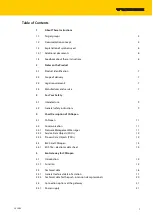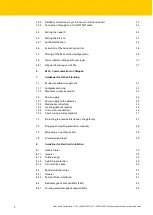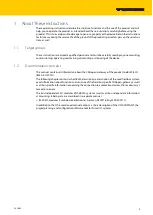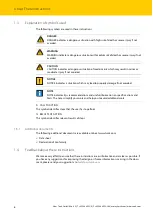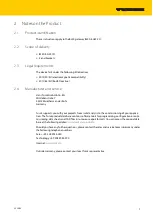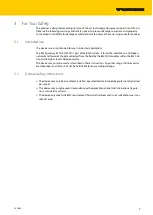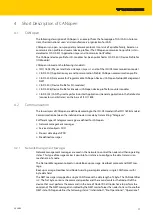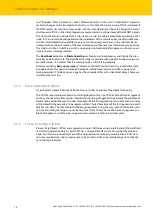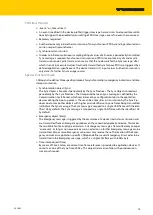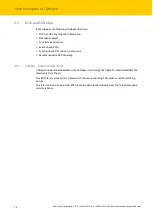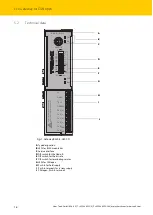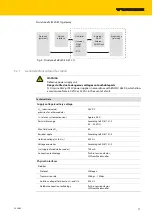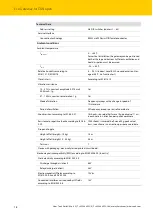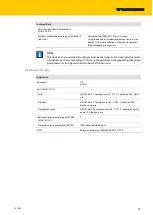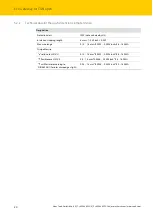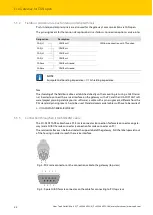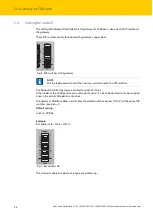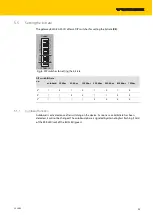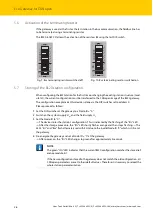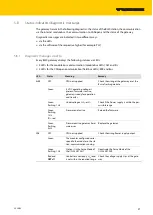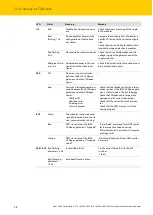
13
2020/09
PDO transmissions
„Event-“ or „timer-driven“:
An event (specified in the device profile) triggers message transmission. An elapsed timer addi
-
tionally triggers the periodically transmitting of PDO-messages, even if no event has occurred.
Remotely requested:
Another device may initiate the transmission of an asynchronous PDO by sending a remote trans
-
mission request (remote frame).
Synchronous transmission:
In order to initiate simultaneous sampling of input values of all nodes, a periodically transmitted
Sync message is required. Synchronous transmission of PDOs takes place in cyclic and acyclic
transmission mode. Cyclic transmission means that the node waits for the Sync message, after
which it sends its measured values. Acyclically transmitted synchronous PDOs are triggered by a
defined application-specific event. The device transmits it's input values. Further transmission is
only done if a further Sync messages occurs.
Special Function Objects
CANopen also defines three specific protocols for synchronization, emergency indication, and time-
stamp transmission.
Synchronization object (Sync)
The Sync Object is broadcast periodically by the Sync Producer. The Sync Object is broadcast
periodically by the Sync Producer. The time period between Sync messages is defined by the
Communication Cycle Period, which may be reset by a configuration tool to the application
devices during the boot-up process. There can be a time jitter in transmission by the Sync Pro
-
ducer due to some other objects with higher prior identifiers or by one frame being transmitted
just before the Sync message. The Sync message is mapped to a single CAN frame with the iden
-
tifier 128 by default. The Sync message is mapped to a single CAN frame with the identifier 128
by default.
Emergency object (Emcy)
The Emergency message is triggered by the occurrence of a device internal error situation and
are transmitted from an Emergency producer on the concerned application device. This makes
them suitable for interrupt type error alerts. An Emergency message is transmitted only once per
‘error event’. As long as no new errors occurs on a device, no further Emergency message can be
transmitted. Zero or more Emergency consumers may receive these. The reaction of the Emer
-
gency consumer is application-specific. CANopen defines several Emergency Error Codes to be
transmitted in the Emergency message, which is a single CAN frame with 8 data byte.
Time stamp object (Time)
By means of Time-Stamp, a common time frame reference is provided to application devices. It
contains a value of the type Time-of-Day. This object transmission follows the producer/con
-
sumer push model.
Содержание BL20-ECO
Страница 1: ...Your Global Automation Partner BL20 E GW CO ECO Gateway for CANopen Instructions for Use...
Страница 2: ...2 Hans Turck GmbH Co KG T 49 208 4952 0 F 49 208 4952 264 more turck com www turck com...
Страница 6: ...Hans Turck GmbH Co KG T 49 208 4952 0 F 49 208 4952 264 more turck com www turck com 4...
Страница 10: ...Notes on the Product Hans Turck GmbH Co KG T 49 208 4952 0 F 49 208 4952 264 more turck com www turck com 8...
Страница 12: ...For Your Safety Hans Turck GmbH Co KG T 49 208 4952 0 F 49 208 4952 264 more turck com www turck com 10...
Страница 53: ...Over 30 subsidiaries and over 60 representations worldwide www turck com D301108 2020 09 D301108...



